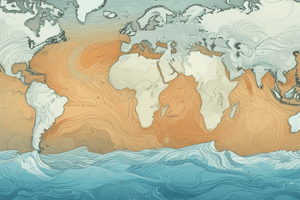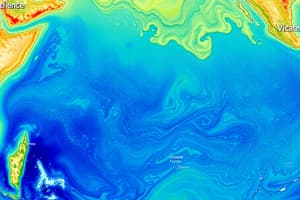Podcast
Questions and Answers
What role does temperature play in driving surface ocean currents?
What role does temperature play in driving surface ocean currents?
- Temperature changes create differences in water density. (correct)
- Temperature affects only the depth of ocean currents.
- Temperature has no effect on surface currents.
- Temperature influences wind patterns that affect currents.
Which factor primarily influences the direction of surface ocean currents?
Which factor primarily influences the direction of surface ocean currents?
- The rotation of the Earth. (correct)
- The salinity levels of seawater.
- The temperature of the ocean floor.
- The gravitational pull of the moon.
How does wind contribute to the movement of surface ocean currents?
How does wind contribute to the movement of surface ocean currents?
- Wind creates cold water upwellings in the ocean.
- Wind only affects deep-sea currents.
- Wind exerts friction on the surface of the water. (correct)
- Wind does not impact ocean currents significantly.
What is the combined effect of temperature, wind, and gravity on ocean currents?
What is the combined effect of temperature, wind, and gravity on ocean currents?
What is primarily responsible for the upwelling of cold water in the ocean?
What is primarily responsible for the upwelling of cold water in the ocean?
Flashcards are hidden until you start studying
Study Notes
Role of Temperature in Surface Ocean Currents
- Temperature variations affect water density, leading to the movement of water masses; warmer water is less dense and tends to rise.
- Tropical regions, being warmer, experience higher evaporation rates and contribute to lower surface pressure, driving currents.
- Cold water from polar regions sinks and flows towards the equator, influencing the overall circulation patterns in the ocean.
Influence of Direction on Surface Ocean Currents
- The primary factor influencing the direction of surface ocean currents is the Earth’s rotation, known as the Coriolis effect.
- The Coriolis effect causes currents to deflect to the right in the Northern Hemisphere and to the left in the Southern Hemisphere, shaping current trajectories.
Contribution of Wind to Surface Ocean Currents
- Wind exerts friction on the ocean surface, transferring energy and generating movement in the water.
- Persistent wind patterns, such as trade winds, are crucial for driving major ocean currents across vast distances.
- The interaction between wind and currents creates gyres, circular movements of ocean water, which are integral to global climate.
Combined Effects of Temperature, Wind, and Gravity on Ocean Currents
- The interplay between temperature-related density changes, wind-driven movements, and gravity creates complex current systems.
- Warm water rises while cold water, being denser, sinks; this vertical movement, combined with surface wind pushing water horizontally, maintains circulation.
- Gravity acts on the differences in water density and topography of the ocean floor, ensuring a continuous flow of water.
Upwelling of Cold Water in the Ocean
- Upwelling is primarily caused by offshore winds that push surface water away from the coastline, allowing deeper, colder water to rise.
- This process is vital for nutrient replenishment, supporting marine ecosystems and enhancing fisheries.
- Coastal regions often experience significant upwelling, leading to highly productive areas rich in marine life.
Studying That Suits You
Use AI to generate personalized quizzes and flashcards to suit your learning preferences.




